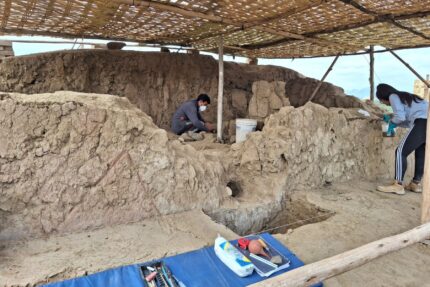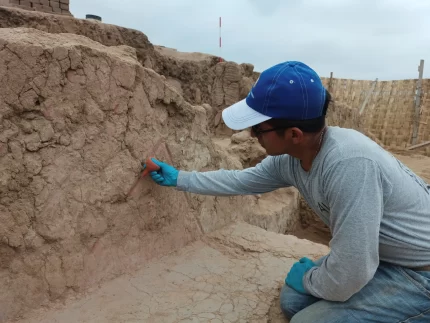 A second monumental polychrome mural has been discovered in the excavation of Huaca Tomabal in the Virú province of northern Peru’s La Libertad region. The new discovery greatly advances the estimated date of the temple. It was previously believed to be about 3,200 years old. The second mural dates the Pre-ceramic period between 4,000 and 4,500 years ago, making it the oldest polychrome painting recorded in the La Libertad region.
A second monumental polychrome mural has been discovered in the excavation of Huaca Tomabal in the Virú province of northern Peru’s La Libertad region. The new discovery greatly advances the estimated date of the temple. It was previously believed to be about 3,200 years old. The second mural dates the Pre-ceramic period between 4,000 and 4,500 years ago, making it the oldest polychrome painting recorded in the La Libertad region.
The first mural was discovered in 2020 after farmers seeking to expand their avocado and sugar cane fields illegally bulldozed 60% of the mound. The destruction of cultural heritage was reported and an emergency archaeological intervention ensued. The area was declared a protected site and the polychrome mural was stabilized in situ.
At the time of the first intervention, archaeologists thought the monumental mural was painted by the Cupisnique people of northern Peru who used a conical adobe type also found in the wall. That would have dated it to about 3,200 years ago.
 Three years later, archaeologists returned to the site for a new intervention. The excavation revealed a second monumental mural on the north side of the huaca. The new mural is almost 10 feet tall and features triangular shapes painted in red and a central figure adorned with scrolls and waves. It is thought to be a stylized depiction of a mythological character (the first mural is believed to represent the spider god), but which character is unknown.
Three years later, archaeologists returned to the site for a new intervention. The excavation revealed a second monumental mural on the north side of the huaca. The new mural is almost 10 feet tall and features triangular shapes painted in red and a central figure adorned with scrolls and waves. It is thought to be a stylized depiction of a mythological character (the first mural is believed to represent the spider god), but which character is unknown.
“The objective of this excavation unit was to define the northeast corner of the enclosure that had been destroyed, which in 2020 allowed me and archaeologist Regulo Franco to find a polychrome wall featuring an anthropomorphic character from the Cupisnique period, as we thought first, but it is much older,” [Feren Castillo Lujan, head of the Viru Valley Archaeological Project,] remarked.
“Indeed, we have confirmed that it (the enclosure) has a curved corner. Besides, the wall is polychrome. There is clear evidence that the wall continues down into the ground, since what we see is only a part of the mural,” he added.
The researcher explained that, according to the building tradition —in which truncated adobe bricks and their variants stand out, as well as the absence of ceramics— it can be concluded that this is a temple dating to the Pre-ceramic or Late Archaic Period….
The curved corner is one of the characteristic architectural elements of Pre-ceramic period ceremonial temples. The other common element found in Pre-ceramic temples is a central interior hearth. Archaeologists hope to uncover the hearth of Huaca Tomabal in future excavations, but they need more funding to continue.
new discovery? when exactly?